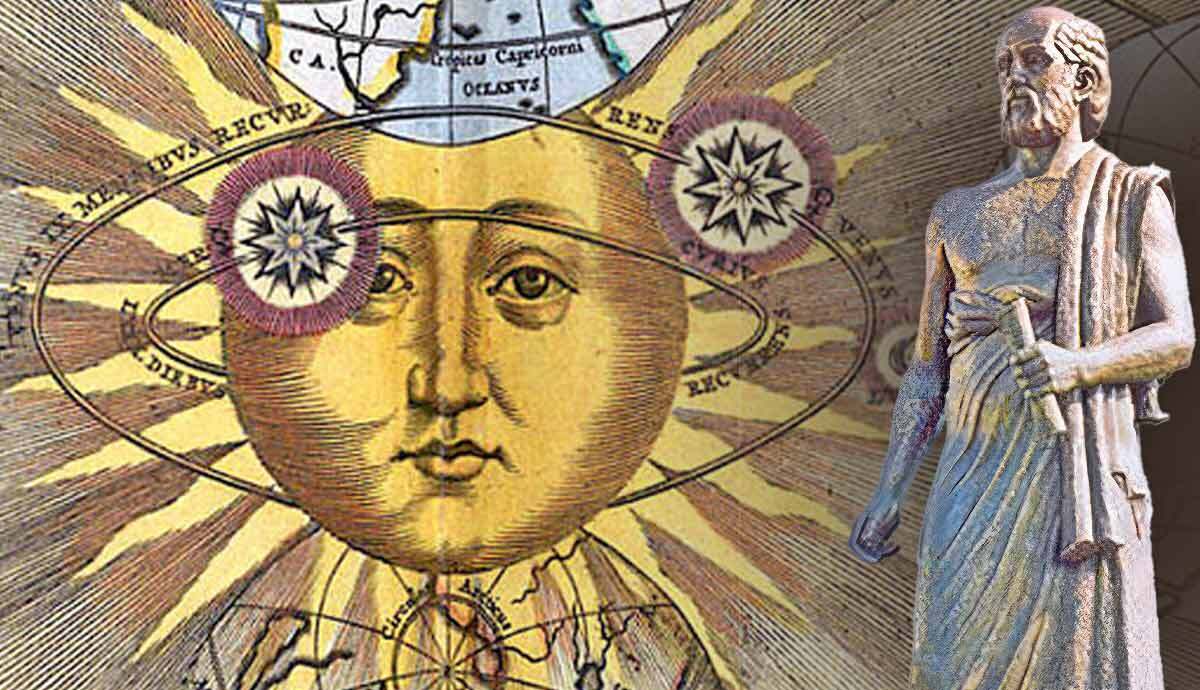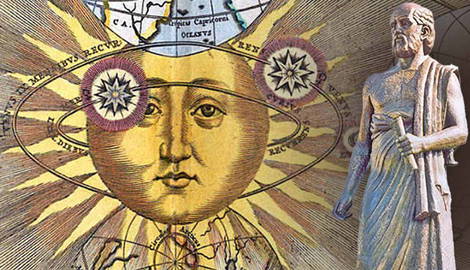
Almost two thousand years before the birth of Copernicus, Aristarchus of Samos had proposed a model of the Universe with the sun in its center. According to his model, the Earth revolves around the Sun while also rotating around its own axis. This system was not widely accepted in Aristarchus’ time as most thinkers would trust the authorities of Plato and Aristotle, who had firmly supported the geocentric system, with the Earth at the center of the Universe.
Who Was Aristarchus of Samos (310 BCE – 230 BCE)?

We do not know much about Aristarchus’ life since not many contemporaries wrote about him. We know that he was born in Samos, around 310 BCE, and he died around 230 BCE in Alexandria. Some authors sporadically mention details about Aristarchus’ life. For example, Archimedes writes that Aristarchus studied at the Lyceum under Strato of Lampsacus. A proponent of the Pythagorean school of thought, Aristarchus approached astronomy through mathematical models to calculate the sizes, distances, and movements of celestial bodies. He mainly focused on the nearest bodies: the Earth, the Moon, and the Sun. His goal was to determine the sizes of the Moon and the Sun, as well as their distance from Earth.
Aristarchus cleverly criticized certain aspects of geocentrism that could not be explained accurately. For example, the geocentric model could not explain the movements of planets that were assumed to orbit around the Earth. This was particularly true for the retrograde motion: at some point, certain planets would move in the opposite direction for a while, before going back to their original direction. Another problem of the geocentric model was the size of the planets: from time to time, they appeared visibly larger and brighter. This was difficult to explain if they indeed revolved around the Earth. Aristarchus’ answer to these issues was simple: the Sun, and not the Earth, was in the center.
“On the Sizes and Distances (of the Sun and Moon)”

While he is best known for his heliocentric model, Aristarchus did not always argue for it. In fact, he wrote an entire book on geocentrism with the title On the Sizes and Distances (of the Sun and Moon). The most likely theory is that this book was an earlier work before he had developed his heliocentric ideas. Another less popular theory was that he gave up on the idea of heliocentrism, probably because his contemporaries rejected it.
This book is Aristarchus’s only extant work and the oldest surviving document that uses geometric models to estimate the sizes and distances of the celestial bodies.
Aristarchus measured the size of the Moon during a total lunar eclipse when the Moon’s disc was entirely in the Earth’s shadow. Using calculations, he correctly concluded that the Earth was larger than the Moon.
Using geometry, he could estimate the sizes and distances between these bodies. First, he calculated that the distance between the Earth and the Sun is much larger than the distance between the Earth and the Moon. He was correct in this assessment, but his calculations underestimated just how huge this difference in distances is. Still, this calculation allowed Aristarchus to conclude that the Moon was much closer to the Earth than the Sun.

Aristarchus also calculated the sizes of the Moon and the Earth. He estimated the Moon’s diameter to be between a third and a fourth of the Earth’s diameter. For the Sun, he estimated its size to be 6 to 7 times larger than the Earth. Again, his calculations were off, particularly in the case of the Sun, whose diameter is about 109 times that of the Earth.
Aristarchus’ calculations were not precise, but his geometric methods for figuring out sizes and distances were correct. Later astronomers, such as Ptolemy and Hipparchus, made recalculations of Aristarchus’ model and arrived at more accurate values for the size and distance of the Moon. The Sun remained more of a mystery, and its size and distance were underestimated in antiquity.
Aristarchus’ incorrect calculations did not come from his faulty methods or ideas but from a lack of appropriate instruments that would allow for more accuracy. Because of this, his numbers were wrong, but his conclusions and geometry were correct. There is also a possibility that his goal was not to arrive at precise numbers but to develop a geometric model that would allow the measurement of the celestial bodies’ sizes and distances.
Heliocentric Model

It is unknown how or when Aristarchus arrived at the idea of a heliocentric system. If his On the Sizes and Distances is indeed a work that precedes his heliocentric ideas, it is possible that its conclusions led him to rethink the relationships between the celestial bodies. Especially the realization that the Sun was the largest of the bodies and much bigger than the Earth. Aristarchus could have followed the principle that the smaller objects orbit the larger ones and since he had concluded that the Earth was smaller, the only logical explanation would be that the Sun was in the center.
Another possible inspiration could have been Philolaus of Croton (c. 470 BCE – c. 385 BCE), who proposed the Central Fire as the center of the universe, with ten planets revolving around it. The ten planets included Counter-Earth (a concept he did not explain), Earth, the Moon, the Sun, and then Mercury, Venus, Mars, Jupiter, Saturn, and the Fixed Stars.
Aristarchus indeed viewed the Sun as a central fire; the Earth orbits around it. He was also correct in his assertion that distant stars were similar fires: other suns that exist in the universe. The reason that we do not perceive them as suns explains Aristarchus, is because stars are much farther away than our Sun or the Moon.

Since no writings are preserved, only a few things are known about Aristarchus’ heliocentric system. We learn about his model through the writings of others, such as Archimedes and Plutarch.
In his work, The Sand Reckoner, Archimedes of Syracuse (c. 287 BCE – c. 212 BCE) writes about the Earth being in the center of the universe and mentions that Aristarchus proposed a different idea of a much larger universe. According to Aristarchus, Archimedes tells us, the Sun and the stars are immovable, the Earth revolves around the Sun, and the size of this universe is the sphere of the fixed stars, which has the same center as the Sun but is immensely larger.

Plutarch mentions Aristarchus and his ideas along the concept of a “Hearth”, which probably refers to the Earth since it was seen as the center of the universe. Plutarch also suggests that Aristarchus’ work received negative reactions and a strong backlash from the scientific community, particularly from Cleanthes, an Athenian stoic philosopher, who claimed that Aristarchus was “disturbing the Hearth of the universe” with his heliocentrism.
Aristarchus could not prove his heliocentric views to his contemporaries. The problem was the limitation of the available instruments, as well as the mathematics of his time. Another issue was the popularity of the geocentric model with Earth in the center, a model that most thinkers in antiquity never doubted.
Aristarchus’ Legacy

Aristarchus’ heliocentric model was not accepted. In fact, there are strong indications that it was quickly rejected. Since Aristotle, a strong (if not the strongest) authority during antiquity, supported the geocentric system, it is likely that Aristarchus’ heliocentric model was not fully considered by other scientists. It also seems that it was not even well-known. There are no mentions of it after Archimedes (until Plutarch’s brief comment). Some of these complaints could have been motivated by religion, since the Greek gods were believed to live on Earth, which was supposed to be the center.
As noted above, Athenian stoic philosopher Cleanthes was strongly against Aristarchus’ heliocentric model. Cleanthes claimed that Aristarchus’ model displaced the Earth. There is a possibility that Cleanthes even suggested that Aristarchus should be tried for his ideas, although this could be a later interpretation. It is also possible that the situation was the opposite: that Aristarchus himself was the one who suggested Cleanthes should be put on trial.
It is also possible that the reactions to the model were not as negative nor as aggressive as is often assumed. The clash with Cleanthes is sometimes described as more of a playful exchange of opinions between the opposing stances but not a serious call to silence Aristarchus. In any case, there is insufficient proof that Aristarchus suffered any consequences for his idea.

However, it is evident that the idea of heliocentrism was not accepted. Aristarchus’ ideas were forgotten. Claudius Ptolemy (c. 100 – c. 170) solidified geocentrism in his treatise “Mathematike Syntaxis”, better known under its Arabic translation, “Almagest”. It will remain the leading model of the universe for centuries.
Heliocentrism did win in the end. In his 1543 book, “On the Revolution of the Celestial Spheres” Nicolaus Copernicus formulated a heliocentric model that will be his legacy. In the early drafts of the work, he mentioned both Philolaus and Aristarchus as early proponents of heliocentrism. Unfortunately, these references were crossed out before printing, and Aristarchus is not mentioned in the published version of the book. Still, early drafts prove that Copernicus was aware of Ancient Greek thinkers who proposed heliocentrism. While the heliocentric model of the universe remains primarily Copernicus’ legacy, it is important to also remember Aristarchus and his work.










